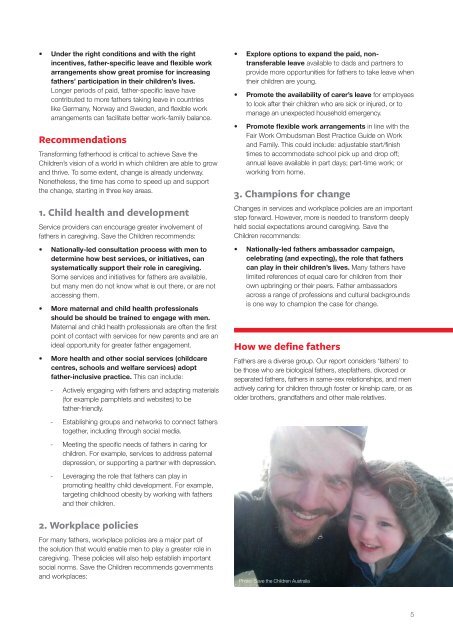State of Australia’s Fathers
1iGWp7w
1iGWp7w
- No tags were found...
You also want an ePaper? Increase the reach of your titles
YUMPU automatically turns print PDFs into web optimized ePapers that Google loves.
• Under the right conditions and with the right<br />
incentives, father-specific leave and flexible work<br />
arrangements show great promise for increasing<br />
fathers’ participation in their children’s lives.<br />
Longer periods <strong>of</strong> paid, father-specific leave have<br />
contributed to more fathers taking leave in countries<br />
like Germany, Norway and Sweden, and flexible work<br />
arrangements can facilitate better work-family balance.<br />
Recommendations<br />
Transforming fatherhood is critical to achieve Save the<br />
Children’s vision <strong>of</strong> a world in which children are able to grow<br />
and thrive. To some extent, change is already underway.<br />
Nonetheless, the time has come to speed up and support<br />
the change, starting in three key areas.<br />
1. Child health and development<br />
Service providers can encourage greater involvement <strong>of</strong><br />
fathers in caregiving. Save the Children recommends:<br />
• Nationally-led consultation process with men to<br />
determine how best services, or initiatives, can<br />
systematically support their role in caregiving.<br />
Some services and initiatives for fathers are available,<br />
but many men do not know what is out there, or are not<br />
accessing them.<br />
• More maternal and child health pr<strong>of</strong>essionals<br />
should be should be trained to engage with men.<br />
Maternal and child health pr<strong>of</strong>essionals are <strong>of</strong>ten the first<br />
point <strong>of</strong> contact with services for new parents and are an<br />
ideal opportunity for greater father engagement.<br />
• More health and other social services (childcare<br />
centres, schools and welfare services) adopt<br />
father-inclusive practice. This can include:<br />
--<br />
Actively engaging with fathers and adapting materials<br />
(for example pamphlets and websites) to be<br />
father-friendly.<br />
• Explore options to expand the paid, nontransferable<br />
leave available to dads and partners to<br />
provide more opportunities for fathers to take leave when<br />
their children are young.<br />
• Promote the availability <strong>of</strong> carer’s leave for employees<br />
to look after their children who are sick or injured, or to<br />
manage an unexpected household emergency.<br />
• Promote flexible work arrangements in line with the<br />
Fair Work Ombudsman Best Practice Guide on Work<br />
and Family. This could include: adjustable start/finish<br />
times to accommodate school pick up and drop <strong>of</strong>f;<br />
annual leave available in part days; part-time work; or<br />
working from home.<br />
3. Champions for change<br />
Changes in services and workplace policies are an important<br />
step forward. However, more is needed to transform deeply<br />
held social expectations around caregiving. Save the<br />
Children recommends:<br />
• Nationally-led fathers ambassador campaign,<br />
celebrating (and expecting), the role that fathers<br />
can play in their children’s lives. Many fathers have<br />
limited references <strong>of</strong> equal care for children from their<br />
own upbringing or their peers. Father ambassadors<br />
across a range <strong>of</strong> pr<strong>of</strong>essions and cultural backgrounds<br />
is one way to champion the case for change.<br />
How we define fathers<br />
<strong>Fathers</strong> are a diverse group. Our report considers ‘fathers’ to<br />
be those who are biological fathers, stepfathers, divorced or<br />
separated fathers, fathers in same-sex relationships, and men<br />
actively caring for children through foster or kinship care, or as<br />
older brothers, grandfathers and other male relatives.<br />
--<br />
Establishing groups and networks to connect fathers<br />
together, including through social media.<br />
--<br />
Meeting the specific needs <strong>of</strong> fathers in caring for<br />
children. For example, services to address paternal<br />
depression, or supporting a partner with depression.<br />
--<br />
Leveraging the role that fathers can play in<br />
promoting healthy child development. For example,<br />
targeting childhood obesity by working with fathers<br />
and their children.<br />
2. Workplace policies<br />
For many fathers, workplace policies are a major part <strong>of</strong><br />
the solution that would enable men to play a greater role in<br />
caregiving. These policies will also help establish important<br />
social norms. Save the Children recommends governments<br />
and workplaces:<br />
Photo: Save the Children Australia<br />
5


